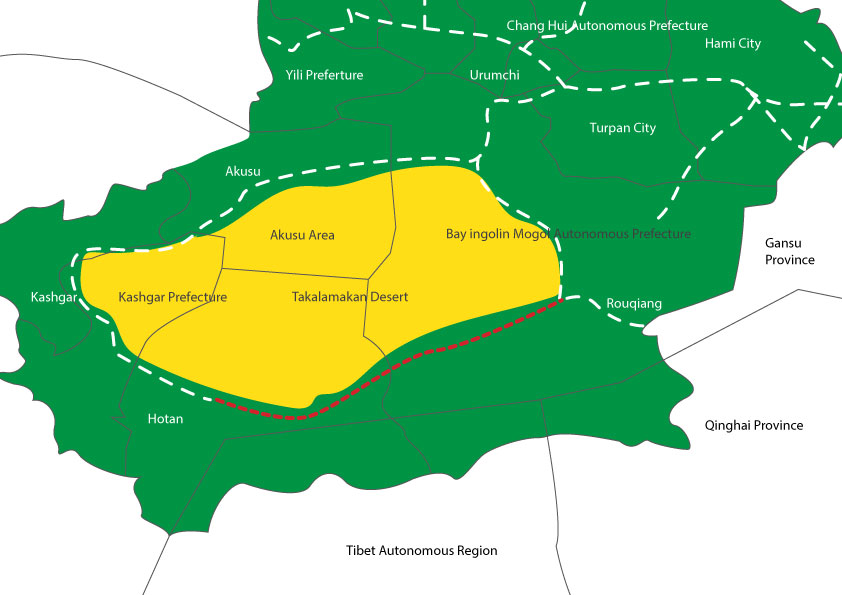China’s Taklimakan Desert Rail Loop To Be Completed In 2022
On September 27, 2021, the Heruo Railway, the final section of the rail network encircling Taklimakan Desert in China’s Xinjiang Province completed laying tracks, setting the foundation for operating the world’s first desert-circling railway in 2022.
The construction of the Heruo Railway began in December 2018. It is designed to connect Hetian City in Southern Xinjiang and Ruoqiang County in Bayingolin Mongolian Autonomous Prefecture also in Southern Xinjiang.
The Heruo Railway connects with the existing Geku, Kahe, and Southern Xinjiang Railway, and collectively forms a closed railway loop around the Taklimakan Desert.
As a regional trunk line in central and western China, the Heruo Railway is a key project in developing an international corridor from China’s western hinterland to South Asia and central and West Asia. It is expected to be open for services in June 2022. Five counties in Southern Xinjiang, including Lopu, Cele, Yutian, Minfeng, and Qiemo, will finally benefit from rail connectivity with the improved transportation infrastructure promoting the economic and social development of Southern Xinjiang, one of China’s poorest and least developed regions.
With a design speed of 120 kilometers per hour, the fully completed railway line is expected to slash travel time between Hetian prefecture in Xinjiang and Xining, capital of Northwest China’s Qinghai Province, from three days to just one. The Taklimakan loop will integrate Southern Xinjiang into a vast network of railways along Belt & Road routes.

China’s efforts in developing its vast western region
China’s ‘Go West’ strategy, which aims to narrow the economic gap between the less developed west and affluent east coast, has entered its third decade.
With the launch of the Belt & Road Initiative (BRI), Beijing hopes to fit China’s western regions, including Xinjiang, into its ambitious BRI blueprint. Xinjiang needs to enhance its position as a traffic hub for China to connect BRI countries in the west.
During the 13th Five-Year Plan period (2015-2020), Xinjiang completed a total investment of RMB 4.1 trillion (US$640 billion) in fixed assets and accelerated the construction of transportation and municipal infrastructure. Over the five-year period, 30,000 kilometers of roads and 1,530 kilometers of railways were added to Xinjiang, and 22 airports were built.
At the beginning of the 14th Five-year Plan, the Xinjiang Development and Reform Commission released its list of key projects in 2021, including 350 key projects in water conservancy, transportation, energy, industry and people’s livelihood, with a total investment of RMB 1,649.3 billion (US$257.5 billion).
As to railway construction, the railway operating mileage reached 7,398 kilometers in Xinjiang by 2020, an increase of 1,530 kilometers in the past five years, and railway connectivity has now reached all the prefectures and cities of Xinjiang.
Urumqi, the capital of Xinjiang, has entered the era of subway. High-speed trains from Urumqi to Xi ‘an have been launched, and Xinjiang’s railway transport has now integrated into the national high-speed railway network. The completion of the Geku line opened a third railway channel to enter and exit Xinjiang. In addition to these developments, there are two other rail projects under development – the reconstruction project of the Lanxin Railway from Jijicaozi to Urumqi and a connection between Aksu to Arar.
While the West has decried investment into Xinjiang for largely misrepresented reasons concerning treatment of parts of the Uyghur population (an issue I discussed here) it should be noted that other Muslim countries are major investors in Xinjiang. There are differing perceptions with the West jumping to conclusions that are misleading. In fact, Xinjiang’s main foreign investment and trade partners are Kazakhstan, Kyrgyzstan and Tajikistan, all Muslim countries. Trade has been booming; figures released August 26, 2021 by Xinjiang customs show that during the period January-July this year, Xinjiang’s exports rose 33%, while imports increased 14%.
Related Reading
About Us
Silk Road Briefing is written by Dezan Shira & Associates. The firm has 28 offices throughout Asia, and assists foreign investors into the region. For strategic advisory and business intelligence issues please contact the firm at silkroad@dezshira.com or visit www.dezshira.com





